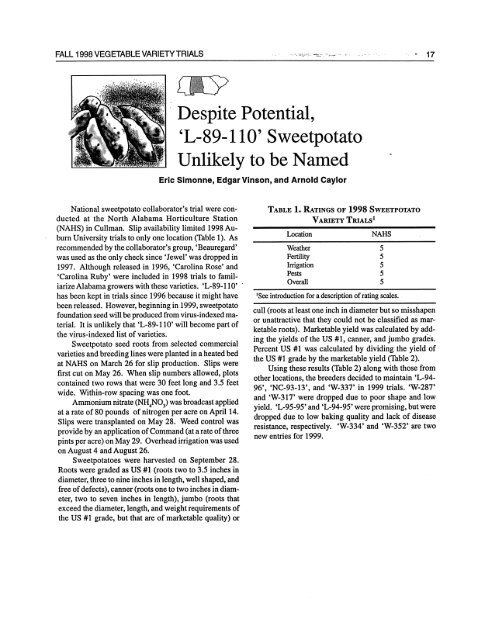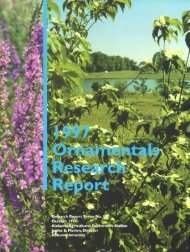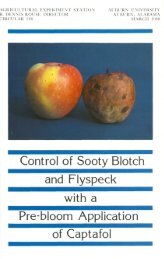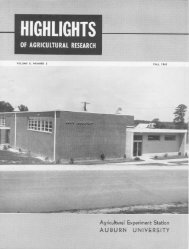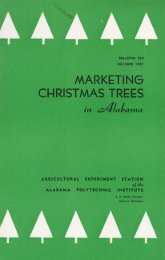FALL TRIALS 1998 VEGETABLE VARIETY - Auburn University
FALL TRIALS 1998 VEGETABLE VARIETY - Auburn University
FALL TRIALS 1998 VEGETABLE VARIETY - Auburn University
You also want an ePaper? Increase the reach of your titles
YUMPU automatically turns print PDFs into web optimized ePapers that Google loves.
<strong>FALL</strong> <strong>1998</strong> <strong>VEGETABLE</strong> <strong>VARIETY</strong> <strong>TRIALS</strong><br />
<strong>FALL</strong> <strong>1998</strong> <strong>VEGETABLE</strong> <strong>VARIETY</strong> <strong>TRIALS</strong> 17<br />
National sweetpotato collaborator's trial were conducted<br />
at the North Alabama Horticulture Station<br />
(NAHS) in Cullman. Slip availability limited <strong>1998</strong> <strong>Auburn</strong><br />
<strong>University</strong> trials to only one location (Table 1). As<br />
recommended by the collaborator's group, 'Beauregard'<br />
was used as the only check since 'Jewel' was dropped in<br />
1997. Although released in 1996, 'Carolina Rose' and<br />
'Carolina Ruby' were included in <strong>1998</strong> trials to familiarize<br />
Alabama growers with these varieties. 'L-89-110'<br />
has been kept in trials since 1996 because it might have<br />
been released. However, beginning in 1999, sweetpotato<br />
foundation seed will be produced from virus-indexed material.<br />
It is unlikely that 'L-89-110' will become part of<br />
the virus-indexed list of varieties.<br />
Sweetpotato seed roots from selected commercial<br />
varieties and breeding lines were planted in a heated bed<br />
at NAHS on March 26 for slip production. Slips were<br />
first cut on May 26. When slip numbers allowed, plots<br />
contained two rows that were 30 feet long and 3.5 feet<br />
wide. Within-row spacing was one foot.<br />
Ammonium nitrate (NH 4NO 3) was broadcast applied<br />
at a rate of 80 pounds of nitrogen per acre on April 14.<br />
Slips were transplanted on May 28. Weed control was<br />
provide by an application of Command (at a rate of three<br />
pints per acre) on May 29. Overhead irrigation was used<br />
on August 4 and August 26.<br />
Sweetpotatoes were harvested on September 28.<br />
Roots were graded as US #1 (roots two to 3.5 inches in<br />
diameter, three to nine inches in length, well shaped, and<br />
free of defects), canner (roots one to two inches in diameter,<br />
two to seven inches in length), jumbo (roots that<br />
exceed the diameter, length, and weight requirements of<br />
the US #1 grade, but that are of marketable quality) or<br />
Despite Potential,<br />
'L-89-110' Sweetpotato<br />
Unlikely to be Named<br />
Eric Simonne, Edgar Vinson, and Arnold Caylor<br />
TABLE 1. RATINGS OF <strong>1998</strong> SWEETPOTATO<br />
<strong>VARIETY</strong> <strong>TRIALS</strong> 1<br />
Location NAHS<br />
Weather 5<br />
Fertility 5<br />
Irrigation 5<br />
Pests 5<br />
Overall 5<br />
'See introduction for a description of rating scales.<br />
17<br />
cull (roots at least one inch in diameter but so misshapen<br />
or unattractive that they could not be classified as marketable<br />
roots). Marketable yield was calculated by adding<br />
the yields of the US #1, canner, and jumbo grades.<br />
Percent US #1 was calculated by dividing the yield of<br />
the US #1 grade by the marketable yield (Table 2).<br />
Using these results (Table 2) along with those from<br />
other locations, the breeders decided to maintain 'L-94-<br />
96', 'NC-93-13', and 'W-337' in 1999 trials. 'W-287'<br />
and 'W-317' were dropped due to poor shape and low<br />
yield. 'L-95-95' and 'L-94-95' were promising, but were<br />
dropped due to low baking quality and lack of disease<br />
resistance, respectively. 'W-334' and 'W-352' are two<br />
new entries for 1999.


